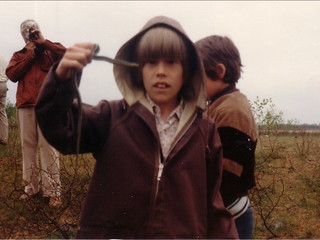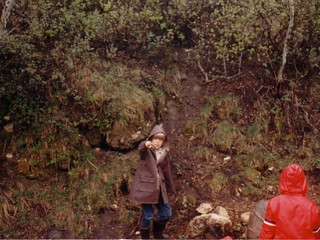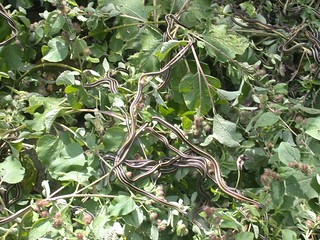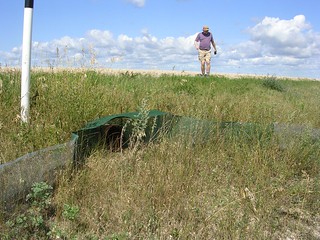The Narcisse Snake Dens in the Off-Season
I thought the Narcisse snake dens weren’t worth visiting in the off-season. I was wrong.
The Narcisse snake dens, just an hour and a half north of Winnipeg, Manitoba, are rightly viewed as a natural wonder: every spring, tens of thousands of Red-sided Garter Snakes (Thamnophis sirtalis parietalis) emerge from hibernation, mate like crazy, and disperse for the summer. And you can watch them do it — at its peak, you’re quite literally tripping over snakes, there are so many of them. Over the past few decades it has slowly grown into a tourist attraction: low-profile even by Manitoba standards, it nonetheless draws visitors from around the world.
I grew up in Winnipeg and, when I was eight years old, visited the dens twice in one season. Many snake enthusiasts who have not been able to make the trip are jealous of me because of it. But I didn’t return until this year, when, to my surprise, even in the off-season the snake dens were still able to put on an impressive show.
In 1980, if memory serves, the dens were nothing special: a fenced, open plain, with no serious indication of its attraction. I went twice one year: once as part of a field trip organized by Professor Ken Stewart of the University of Manitoba; then, maybe a month later, as part of a field trip where I cleverly stowed away with a class from a school in another part of Winnipeg. (It said something about my known snake obsessiveness that my school facilitated this trip.)
I came, I saw, I played with snakes. It was cold enough — something like 9°C (48°F) — and the snakes were preoccupied enough (I’m relatively certain that every snake I encountered was male) that no snake put up a fuss, leaving me with the impression that wild garter snakes were completely innocuous if not outright tame.
And then, after keeping a few local garter snakes as pets during my elementary school years (this was back when harvesting them was quite legal, in season), I moved on to other things. The dens grew in fame, and had their facilites upgraded, but I was no longer paying attention. I’ve always had more interests than time to pursue them.
By the time I was interested in snakes again, I was no longer living in Winnipeg. And, though I visited when I could, it was never during the snake dens’ “prime time” — the period in late April and early May when they emerged en masse and made a spectacle of their mating activities. It never occurred to me that there would be anything worth seeing in the off-season.
Last month, though, I changed my mind. We were in Winnipeg, visiting my family; my partner Jennifer — who’s as nuts about snakes as I am — was visiting Manitoba for the first time, we had our car with us, and it occurred to me that visiting the den site would be a reasonable way to pass the time, regardless of whether there were any snakes there. I figured that the chances were good that we’d see at least a few snakes, and that would probably be enough. The den status page suggested that there’d be something worth seeing in late August or early September; I thought we were still too early even for that.
In the end, we saw more than a few. As it turned out, the snakes were coming back to the dens a little earlier than advertised.
Inwood
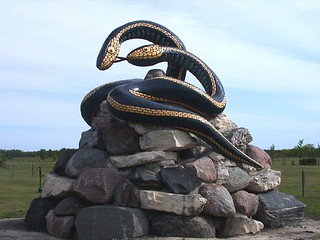 Our first stop was Inwood, Manitoba, which is south of Narcisse but on the way. Before the dens north of Narcisse became a tourist attraction in their own right and put Narcisse’s name on the map, Inwood — a tiny village, but larger than Narcisse — was the informal garter snake capital of Manitoba. In recognition of that fact, and presumably to reassert its claim, in 1995 Inwood erected a statue of two red-sided garter snakes. I wanted a picture — where else in the world, after all, would you find a statue of garter snakes built by the community?1
Our first stop was Inwood, Manitoba, which is south of Narcisse but on the way. Before the dens north of Narcisse became a tourist attraction in their own right and put Narcisse’s name on the map, Inwood — a tiny village, but larger than Narcisse — was the informal garter snake capital of Manitoba. In recognition of that fact, and presumably to reassert its claim, in 1995 Inwood erected a statue of two red-sided garter snakes. I wanted a picture — where else in the world, after all, would you find a statue of garter snakes built by the community?1
The statue is easy to miss if you’re driving through Inwood on Highway 17; it’s on the northeast side of town in an open area. (Look right as you drive through on your way to Narcisse.) There’s not much else to it, though, so we snapped our photos and prepared to get back on the road to Narcisse.
Just before getting back in the car, though, I stopped at the outhouses for a pit stop. As soon as I opened the door, I spotted a garter snake crawling across the concrete floor! The first of our little expedition. It was a male. True to form for the area, he had very little red pattern — which comes as a surprise to those whose experience with parietalis is limited to captive-bred specimens descended from other localities. But I was a little surprised to see how feisty he was, though I immediately understood why.
 My previous experience with wild red-sided garter snakes, you will remember, was limited to visiting the Narcisse dens in springtime, where I mainly saw males during mating season. Cold, horny snakes tend not to bite or musk; warm snakes outside of mating season certainly try. And, as I was to learn that day, Manitoba red-sided garter snakes were just as nervous and just as smelly as their eastern counterparts, whose attitude had previously taken me a bit off guard after my placid childhood experience.
My previous experience with wild red-sided garter snakes, you will remember, was limited to visiting the Narcisse dens in springtime, where I mainly saw males during mating season. Cold, horny snakes tend not to bite or musk; warm snakes outside of mating season certainly try. And, as I was to learn that day, Manitoba red-sided garter snakes were just as nervous and just as smelly as their eastern counterparts, whose attitude had previously taken me a bit off guard after my placid childhood experience.
Back on the road, driving through beautiful downtown Inwood,2 we began seeing more snakes on the road — some live, some dead. It was late morning and they were coming out to bask. Where had they been before? (Probably still there, but we were looking for the statue, not paying attention to the road.)
I began to think that we might see more than one or two snakes at the den site.
The Narcisse Dens
After Inwood, I watched the road nervously for snakes; we saw a few, but, I believe — I hope — we didn’t run any over.
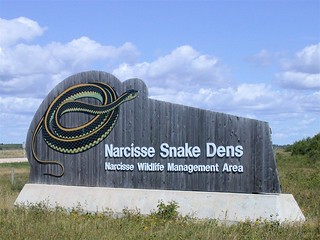 A large sign announced our arrival, and heralded the changes that had taken place at the snake dens in the quarter century since I’d last been there.
A large sign announced our arrival, and heralded the changes that had taken place at the snake dens in the quarter century since I’d last been there.
Where before it was a relatively open plain, now, in addition to a couple decades’ worth of tree growth, there were trails, washrooms, viewing platforms and interpretative signs. The trails take you to half a dozen snake dens in a three-kilometre loop (we stopped at the first two, the latter of which was, I think, the very den I had visited 26 years before). It was, in other words, a developed attraction, with everything but a gift shop. And people — I think we were the only ones there, but then it was the off-season. Supposedly.
 Along the trail to the dens, we began catching glimpses of garter snakes. They were basking at the edges of the trail, it appeared, and retreated quickly into the grass and shrubbery, where we could not even see them much less catch them, as we approached. You had to be very quiet, and very quick, if you hoped to so much as photograph one basking beside the trail, much less catch one. It was a warm August morning, and they weren’t exactly torpid.
Along the trail to the dens, we began catching glimpses of garter snakes. They were basking at the edges of the trail, it appeared, and retreated quickly into the grass and shrubbery, where we could not even see them much less catch them, as we approached. You had to be very quiet, and very quick, if you hoped to so much as photograph one basking beside the trail, much less catch one. It was a warm August morning, and they weren’t exactly torpid.
As we rounded a corner, we saw even more snakes basking in the middle of the trail. It was a surreal sight: as we approached, they darted to the edges; as we passed, they came back to the trail behind us, and resumed their sun-loving ways. I was surprised at how shrewd they were. If human contact had affected their behaviour, it had made them wary rather than tame. We managed to catch a few more along the trail to photograph; they musked, writhed and were generally annoyed (though I’d seen worse from eastern garters).
So, we were seeing snakes, but only glimpses of them for the most part. Not bad, I thought to myself, given the warm day and the fact — again — that it was the off-season.
It was at the viewing platform for the second den that I realized that I had arrived at the El Dorado of garter snake enthusiasts. My admittedly low expectations were suddenly exceeded in a most spectacular fashion. There were snakes everywhere — on the path (of course), coming up through the deck boards, and, most importantly, in the den itself. There were hundreds of them in there, basking on the rocks and on the bushes that tangled themselves through the pit.
I stood transfixed. Actually, I did more than stand: I’d been taking photos throughout our short hike, leaving Jennifer to the job of grabbing snakes and pressing them into service as photographic subjects. (By this point she had been musked more than once, and was feeling pungent.) But while I was taking my photos, the snakes had one more surprise for me: one crawled up from the deck boards and crawled past my boot, unconcerned at my presence so long as I stood still and made no threatening moves.
If this was the off-season, what was it like at its peak?
Coda
On our way out, I had a look at some of the snake fencing and tunnels that lined Highway 17 at the entrance to the dens. These measures were put into place to reduce the obscenely high rates of road mortality endured by the snakes as they crossed the highway on their way to and from the dens. Fences, maybe a foot high, were installed to funnel snakes into small culverts under the highway.
It apparently has worked, though it’s by no means perfect. A larger snake could climb over those fences if it was determined enough, and there’s nothing to stop a snake from crawling onto the highway via the road to the dens. The road is not hermetically sealed. Fortunately, Highway 17 is not a busy highway: it passes through an extremely depopulated part of rural Manitoba.
Even so, snakes were still dying on the road: I noticed at least a half-dozen squashed garter snakes near the entrance to the dens. Not the best first impression for visitors, but what can you do? Warning signs are apparently put up during high seasons; I wonder if it might not hurt to put them up year-round. As I learned that day, there’s still plenty of snakes around during the off-season.
Notes
- Small Canadian towns have a tendency to erect statues as a tourism gimmick; see the Big Things web site.
- I’m being facetious; the town’s population is well under 200. Narcisse’s was under 50 when Manitoba road maps were reporting population sizes more than 20 years ago.
